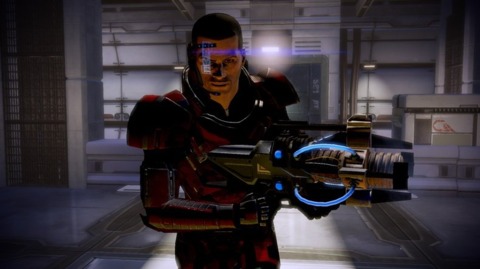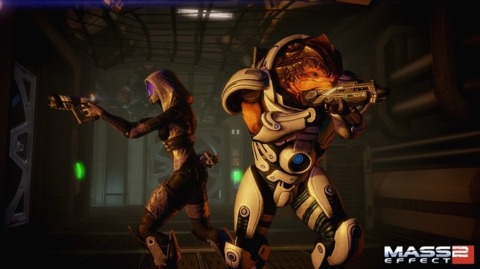Mass Effect 2's shooter shift examined
GDC 2010: Lead gameplay designer Christina Norman talks about amping up the intensity with heavier emphasis on real-time combat in BioWare's sci-fi role-playing game.
Who Was There: As the 2010 Game Developers Conference entered the homestretch, BioWare lead gameplay designer Christina Norman reflected on the changes made to the company's latest sci-fi franchise in "Where Did My Inventory Go? Refining Gameplay in Mass Effect 2."

What She Talked About: Norman began by noting that the original Mass Effect had a far more traditional role-playing game feel. In particular, the game's power wheel (where players select their abilities) allowed for access to up to 20 abilities, each of which was on a separate cooldown timer. She also pointed out that the game would pause as players stopped to select their ability or survey the battlefield.
With Mass Effect 2, she said that BioWare wanted a lot more real-time gameplay, with an emphasis on weapons and cover. The power wheel would remain, she said, but the team wanted to change it so that it was far less intrusive and a lot easier to navigate. The team also sought to capture more satisfying combat, which would involve making the game feel more like a shooter and not rely on the underlying RPG roll-dice-to-hit mechanic.
Mass Effect's often unwieldy inventory system was also targeted as a place for improvement. Norman noted that in the original it could be cumbersome to swap your squad members' weapons with one another and that the sheer number of largely undifferentiated weapons often felt like junk to be sold. In Mass Effect 2, she said, the team wanted players to feel an affinity for their weapon of choice.
Game balance was also an area that needed improvement, she said. The original Mass Effect gave players too much opportunity to trivialize the game with overpowered combos. She said that improper game balance really diminished its overall quality.
So how did BioWare go about addressing these problems in Mass Effect 2? Norman said that the team originally took a design document approach and planned out all the features that would help them reach their design goals. However, she said that none of these features actually made it into the game and that they found the process of prototyping far more valuable.
Because the engineers were preoccupied with other work, Norman and her team did their initial prototyping using the original Mass Effect's engine, making changes only to specific values like weapon damage or accuracy. And though the work ended up being mostly throwaway, she said that the experiments helped them get a better handle on the limitations of their current setup.
Getting into the brass tacks of design, Norman said that it became paramount to build great shooter gameplay. To do so, she said that they completely turned off the game's RPG system so that they could focus on crafting the shooter elements, a move Norman called the most important of the project.

Norman also said that the team spent time analyzing what their competitors were doing well, mostly because BioWare's focus has never been on this genre. This involved standardizing the game's control scheme so that players wouldn't have to relearn the gamepad layout. One other way was to hammer out the flaws in the original's cover mechanic.
Weapons also received attention. The team focused on addressing issues from the original, including the lack of headshots and aim assist, as well as the fact that enemies didn't react when shot. She said they also wanted to build better weapons that felt different from each other, noting that the final game had 19 weapons with 108 tuning variables.
Once this process was complete--after a span of about three months--the team then began to incorporate RPG elements back into the game. Norman was quick to point out that though the RPG gameplay had been "off," development on it remained ongoing.
Norman then shifted her talk to the concept of building for intensity. She said that class design was particularly important in Mass Effect 2, since the team really wanted to create highly differentiated play types, even if it meant cutting some of the possible choices. Returning to the concept of the power wheel, she said that the constant pausing and selecting of powers took away from intensity, which is why in Mass Effect 2, players were given the ability to map three of their own abilities and two of their squadmates' abilities to the controller for use in real time.
Adding in a global cooldown timer for all abilities also helped ramp up intensity, she said, because it allowed players to use more powers, more frequently. She also said that it was important to add regenerating health, because it got players away from playing erratically and relying on health kits. Enemy consistency was also important, she said, because players should be able to look at a combatant and know exactly what kind of issues they are facing. This would eliminate the immersion-breaking act of having players look at, say, the enemy's name bar to figure out its strengths and weaknesses.
Due to time constraints, Norman quickly breezed through the remainder of her talk, spending a few minutes on the game's RPG system. She said that it was important not to dumb down the RPG elements but to still make them easier to use. As an example of this, she compared the original game's leveling system to Mass Effect 2's. The former, she said, offered too many choices that weren't particularly representative of how they would impact the game. In Mass Effect 2, the leveling options were pared down and made more descriptive.
Norman also said that armor personalization was surprisingly popular in Mass Effect 2, a feature that wasn't available in the original.
Quote: "Shooter combat must be fun without being propped up by RPG mechanics." --Christina Norman, on crafting the gunplay in Mass Effect 2.
Takeaway: The gameplay difference between the original Mass Effect and its sequel is marked, and that wasn't accidental. Norman's team specifically set out to craft a sharper shooter experience that could stand up against the gunplay found in competitors' offerings, while maintaining BioWare's strong tradition of narrative-driven, RPG-heavy gameplay.
Sclash - Console Release Date Trailer Kingdom Come: Deliverance 2 - Official Cinematic Announcement Trailer Stellar Blade - BIBI ‘Eve’ Official Music Video Trailer | PS5 Apex Legends: Urban Assault Collection Event Trailer Total War: WARHAMMER III - Elspeth von Draken Gameplay Showcase Genshin Impact - "Arlecchino: Sleep in Peace" | Official Character Teaser Minecraft – Kung Fu Panda DLC Trailer Potionomics: Masterwork Edition - Official Announcement Trailer Snowbreak: Containment Zone - "Gradient of Souls" Version Trailer Harold Halibut GameSpot Video Review Nancy Drew: Mystery of the Seven Keys | World Premiere Official Trailer Modern Warfare III & Warzone - Official Cheech & Chong Bundle Gameplay Trailer
Please enter your date of birth to view this video
By clicking 'enter', you agree to GameSpot's
Terms of Use and Privacy Policy
Got a news tip or want to contact us directly? Email news@gamespot.com
Join the conversation